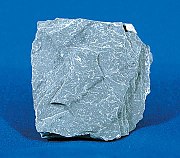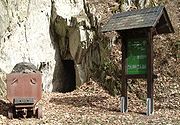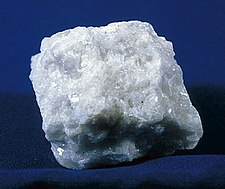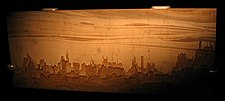Sunday, June 10, 2007
tyheminiral tantaliete
 THE MINERAL TANTALITE
THE MINERAL TANTALITE
- Chemical Formula: (Fe, Mn)(Ta, Nb)2O6, Iron Manganese Tantalum Niobium Oxide.
- Class: Oxides and Hydroxides
- Uses: An ore of tantalum and niobium and as mineral specimens.
- Specimens
Tantalite is the most widespread tantalum mineral and makes for an important ore of the industrially useful metal. Tantalum is used in alloys for strength and higher melting points, in glass to increase the index of refraction, and in surgical steel, as it is non-reactive and non-irritating to body tissues.
Tantalite forms a series with the mineral columbite. In fact the two are often grouped together as a semi-singular mineral called columbite-tantalite in many mineral guides. A series is where two or more elements can occupy the same places within a crystal structure and their respective percentages can then vary. The two minerals of this series have similar properties since they have the same structure and similar chemistries (tantalum and niobium are very similar elements). Tantalite is the more tantalum rich end member and columbite is the more niobium rich end member. Niobium had been called columbium hence the name columbite.
Tantalite's greatest difference from columbite is its much greater specific gravity, 8.0+ compared to columbite's 5.2. Other properties that vary slightly are color, transparency and streak. Both minerals can be found more or less together in granitic pegmatites rich in lithium and phosphorus minerals with columbite concentrated at the edges of the pegmatite and tantalite enriched in the core.
Tantalite has a series of its own. The iron and manganese amounts vary considerably without much effect on properties. However the two end members are recognized as distinct minerals although collectors have found this to be rather cumbersome and generally prefer tantalite to the non-unique names of ferrotantalite and manganotantalite.
Tantalite has a dimorphic relationship to another mineral called
As mineral specimens, tantalite can be a nice addition to one's collection. Good crystals are both complex and handsome. Although the color selection is usually limited too black to brown the luster is generally good. Manganese rich tantalites can be brown and translucent.
PHYSICAL CHARACTERISTICS:
- Color is dark black, iron-black to dark brown or even reddish brown.
- Luster is submetallic to almost resinous.
- Transparency: Crystals are nearly opaque being transparent in thin splinters.
- Crystal System is orthorhombic; 2/m 2/m 2/m
- Crystal Habits include stubby prismatic crystals with complexly faceted or rounded terminations. Also very flat tabular crystals sometimes aggregated together in parallel or nearly parallel groups. Can also be granular and massive.
- Cleavage is good in one direction.
- Fracture is subconchoidal.
- Hardness is 6 - 6.5
- Specific Gravity is approximately 8.0+ when pure (very heavy for non-metallic minerals).
- Streak is brownish-red to black.
- Other Characteristics: Some specimens may show a bluish iridescent tarnish and demonstrate weak magnetism.
- Associated Minerals include albite, spodumene, cassiterite, microcline, lepidolite, apatite, beryl, microlite, tourmalines and amblygonite.
- Notable Occurrences include Newry, Maine; San Diego Co., California; Colorado and Amelia, Virginia, USA; Renfrow County, Ontario, Canada; Madagascar; Sweden; Norway and Finland.
- Best Field Indicators are crystal habit, streak, associations and specific gravity.
THE MINERAL MAGNETITE
 THE MINERAL MAGNETITE
THE MINERAL MAGNETITE
- Chemical Formula: Fe3O4, Iron Oxide
- Class: Oxides and Hydroxides
- Group: Spinel
- Uses: Major ore of iron and as mineral specimens
- Specimens
Magnetite is a natural magnet, hence the name, giving it a very nice distinguishing characteristic. Explaining the magnetism is not easy but here is a go at it. Remember, electricity produces magnetic fields just as magnetism produces electic fields. Magnetite is a member of the spinel group which has the standard formula A(B)2O4. The A and B represent usually different metal ions that occupy specific sites in the crystal structure. In the case of magnetite, Fe3O4, the A metal is Fe +2 and the B metal is Fe +3; two different metal ions in two specific sites. This arrangement causes a transfer of electrons between the different irons in a structured path or vector. This electric vector generates the magnetic field.
PHYSICAL CHARACTERISTICS:
- Color is black.
- Luster is metallic to dull.
- Transparency: Crystals are opaque.
- Crystal System is isometric; 4/m bar 3 2/m
- Crystal Habits are typically octahedrons but rarely rhombododecahedron and other isometric forms, most commonly found massive or granular. Twinning of octahedrons into spinel law twins is seen occassionally.
- Cleavage is absent although octahedral parting can be seen on some specimens.
- Fracture is conchoidal.
- Hardness is 5.5 - 6.5
- Specific Gravity is 5.1+ (average for metallic minerals)
- Streak is black.
- Associated Minerals are talc and chlorite (schists), pyrite and hematite.
- Other Characteristics: Magnetism stronger in massive examples than in crystals, striations on crystal faces (not always seen).
- Notable Occurrences include South Africa, Germany, Russia and many locallities in the USA.
- Best Field Indicators are magnetism, crystal habit and streak.
iron nickel
- Chemistry: Fe-Ni, Elemental Iron-nickel
- Class: Elements
- Group: Iron
- Uses: as a mineral specimen and scientific studies.
- Specimens
Native Iron is quite often a misnomer as natural iron is not necessarily "native" to Earth since it rarely occurs on the Earth's surface by terrestrial processes. It is mostly found in the form of meteorites that have impacted the Earth's surface. A few rare terrestrial gabbros and sulfide deposits do contain elemental iron-nickel deposits, these are the only truly native iron-nickel. All natural iron, whether it is native or meteoritic, is actually an alloy of iron and nickel. The two elements are combined in varying percentages from less than 6% nickel to as much as 75% nickel, although iron is by far more common than nickel.
The meteorites that contain iron-nickel crystals are facinating in their possible origins and diversity. It is postulated that another planet similar to Earth (a rocky planet) broke apart early in the formation of the solar system and is responsible for the iron-nickel debris that rains down upon the Earth on a daily basis. Since it is known that the Earth has a substantial amount of elemental iron and nickel in its core, this leads credence to this theory and gives us much to think about. Many, however, believe the meteor debris to be left over primordial material that the Earth and the other planets were built from.
Meteorites are very diverse and even novice collectors can distinguish samples from different known meteorites by their unique character. Often these meteorites have inclusions of large crystals of other minerals such as olivines or pyroxenes, etc or the iron has a unique crystal pattern that is characteristic.
Due to the nature of iron, care should be used in the preserving of valuable iron-nickel samples. Rust is iron's worst enemy and it is recommended to store iron samples with a dehydrating agent (dessicant).
PHYSICAL CHARACTERISTICS:
- Coloris steel gray or black.
- Luster is metallic.
- Transparency is opaque.
- Crystal System is isometric; 4/m bar 3 2/m
- Crystal Habits crystal form is extremely rare, when etched, meteoritic examples may show interesting and complicated intergrowths of cystals according to different nickel-iron concentrates. Terrestrial samples are massive and appear as small flakes and irregular masses. Meteoritic samples are usually rounded, pitted and irregular.
- Cleavage is absent but crystals will have distinct parallel partings.
- Fracture is hackly.
- Streak is gray metallic.
- Hardness is 4-5
- Specific Gravity is 7.3-7.8 (heavy even for metallic)
- Other Characteristics: malleable, strongly attracted to magnets.
- Associated Minerals are olivine, pyroxenes, and some minerals that are only found in meteorites. In terrestrial samples it is found with gold and platinum and with sulfide ores.
- Notable Occurrences for meteoritic iron are best found in Antarctica, where meteorites are easy to spot against a background of snow and ice. Many specimens are found in Diablo Canyon, Arizona, USA; and in Gibbeon, Hoba, Namibia. Also Meteor Crater (Barringer Crater), Arizona, USA; Australia; Poland and elsewhere. For terrestrial iron, good specimens can be found in the Kola Pennisula, Russia; Disco Island, Greenland; Kassel, Germany and New Zealand.
- Best Field Indicators are color, malleability, attraction to magnets and forms.
slate
Slate
From Wikipedia, the free encyclopedia
Slate is a fine-grained, homogeneous, metamorphic rock derived from an original shale-type sedimentary rock composed of clay or volcanic ash through low grade regional metamorphism. The result is a foliated rock in which the foliation may not correspond to the original sedimentary layering.
Contents[hide] |
[edit] Chemical composition
Slate is mainly composed of quartz and muscovite or illite, often along with biotite, chlorite, hematite, and pyrite along with, less frequently, apatite, graphite, kaolin, magnetite, tourmaline, or zircon as well as feldspar. Occasionally, as in the purple slates of North Wales, ferrous reduction spheres form around iron nucelei, leaving a light green spotted texture - the spheres sometimes deformed by a subsequent applied stress field to ovoids, which appear as ellipses when viewed on a cleavage plane of the specimen.
[edit] Uses of slate
Slate can be made into roofing slates, also called roofing shingles, installed by a slater. Slate has two lines of breakability: cleavage and grain. This makes it possible to split slate into thin sheets. Fine slate can also be used as a whetstone to hone knives. Due to its thermal stability and chemical inertness, slate has been used for laboratory bench tops and for billiard table tops. In 18th and 19th century schools, slate was extensively used for blackboards and individual writing slates for which chalk pencils were used. Because it was a good electrical insulator and was fireproof, it was used to construct early 20th century electric switchboards and relay controls for large electric motors.
Slate tiles are often used for interior and exterior flooring or wall cladding. Tiles are installed and set on mortar and grouted along the edges. Chemical sealants are often used on tiles to improve durability and appearance, increase stain resistance, reduce efflorence, and increase or reduce surface smoothness. Tiles are often sold gauged, meaning that the back surface is ground for ease of installation.
Slate is often used as a decor in freshwater aquariums. Slate will not alter the chemistry of water (except in the slate containing felspar which may leech silicates into the water resulting in excess diatom growth in marine aquaria). When broken, slate produces a natural appearance while remaining relatively flat and can be easily stacked. Silicon glue adheres to slate, creating a non-toxic bond to secure it. It is also used in stairs and pathways for the same reasons.
Traditional Go equipment uses slate for the black pieces.
[edit] Slate extraction
Slate-producing regions include Cornwall (famously the town of Delabole), Wales and Cumbria (see Burlington Slate Quarries and Skiddaw Slate) in the United Kingdom (see slate industry in Wales), Liguria in northern Italy especially between the town of Lavagna (which means chalkboard in Italian) and Fontanabuona valley, Portugal especially around Valongo in the north of the country, Germany (Moselle River-region, Hunsrück, Eifel, Westerwald, Thuringia, north-Bavaria), Alta, Norway, Galicia, Brazil around Papagaio in Minas Gerais, the east coast of Newfoundland, the Slate Belt of Eastern Pennsylvania, and the Slate Valley of Vermont and New York. Granville, New York, of the Slate Valley claims to be the colored slate capital of the world.
There was also a major slating operation in Monson, Maine during the late 19th and early 20th centuries. The slate found in Monson is usually a dark purple to blackish color, and many local structures are still rooved with slate tiles. Of many operations there is only one business currently operating. The output was so great it formed a train route throughout the woods of Monson and as many as 18 quarries were made. St. Patricks's Cathedral in New York's roof was made from roofing slate from Monson, as well as the Headstone of John F. Kennedy.
Slate is also found in the Arctic and was used by the Inuit to make the blades for ulus. China has vast slate deposits; in recent years its export of finished and unfinished slate has increased.
white marble
Marble
From Wikipedia, the free encyclopedia
Marble is a metamorphic rock resulting from the metamorphism of limestone, composed mostly of calcite (a crystalline form of calcium carbonate, CaCO3). It is extensively used for sculpture, as a building material, and in many other applications. The word 'marble' is colloquially used to refer to many other stones that are capable of taking a high polish.
Faux marble or faux marbling is a wall painting technique that imitates the color patterns of real marble (not to be confused with paper marbling). Marble dust can be combined with cement or synthetic resins to make reconstituted or cultured marble.
Places named after the stone include Marble Arch, London; the Sea of Marmara; India's Marble Rocks; and the towns of Marble, Minnesota; Marble, Colorado; and Marble Hill, Manhattan, New York. The Elgin Marbles are marble sculptures from the Parthenon that are on display in the British Museum. They were brought to Britain by the Earl of Elgin.
Contents[hide] |
[edit] Origins
Marble is a metamorphic rock resulting from regional or rarely contact metamorphism of sedimentary carbonate rocks, either limestone or dolostone. This metamorphic process causes a complete recrystallization of the original rock into an interlocking mosaic of calcite, aragonite and/or dolomite crystals. The temperatures and pressures necessary to form marble usually destroy any fossils and sedimentary textures present in the original rock.
Pure white marble is the result of metamorphism of very pure limestones. The characteristic swirls and veins of many colored marble varieties are usually due to various mineral impurities such as clay, silt, sand, iron oxides, or chert which were originally present as grains or layers in the limestone. Green coloration is often due to serpentine resulting from originally high magnesium limestone or dolostone with silica impurities. These various impurities have been mobilized and recrystallized by the intense pressure and heat of the metamorphism.
[edit] Kinds of marble
Some historically important kinds of marble, named after the locations of their quarries, include:
- Durango Marble from Coyote Quarry, Mexico
- Thassos from Greece
- Paros from Greece
- Rouge de Rance from Rance, Belgium
- Penteli from Greece
- Carrara and Luni from Italy
- Proconnesus from Turkey
- Connemara from Ireland
- Brač from the island of Brač, Croatia
- Black Marble from Kilkenny, Ireland
- Macael from Spain
- Makrana from India
- Boticena and Onyx(Green) from Pakistan
- Danby from Vermont
- Yule from Colorado
- Royal White from China
- Beijing White from China
- Vietnam White from Vietnam
- Llano Pink from Central Texas
White marbles, like Carrara in Italy, Royal White and Bejing White in China, have been prized for sculpture since classical times. This preference has to do with the softness and relative isotropy and homogeneity, and a relative resistance to shattering. Also, the low index of refraction of calcite allows light to penetrate several millimeters into the stone before being scattered out, resulting in the characteristic "waxy" look which gives "life" to marble sculptures of the human body.
[edit] Construction marble
In the construction trade, the term "marble" is used for any massive, crystalline calcitic rock (and some non-calcitic rocks) useful as building stone. For example, Tennessee Marble is really a massive, highly fossiliferous gray to pink to maroon Ordovician dolostone, known as the Holston Formation by geologists.
[edit] Industrial use of marble
Colorless marbles are a very pure source of calcium carbonate, which is used in a wide variety of industries. Finely ground marble powder is a component in paints, toothpaste, and plastics; calcium carbonate can also be reduced under high heat to calcium oxide (also known as "lime"), which has many applications including being a primary component of most cements.
[edit] Etymology
The word "marble" derives from the Greek marmaros, "shining stone" (OED). This stem is also the basis for the English word "marmoreal" meaning "marble-like".
[edit] Cultural associations
As the favorite medium for Greek and Roman sculptors and architects, marble has become a cultural symbol of tradition and refined taste. Its extremely varied and colorful patterns make it a favorite decorative material, and it is often imitated in background patterns for computer displays, etc.
In folklore, marble is associated with the astrological sign of Gemini. Pure white marble is an emblem of purity. It is also an emblem of immortality, and an insurer of success in education.








